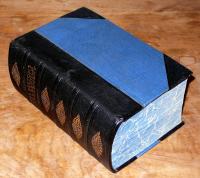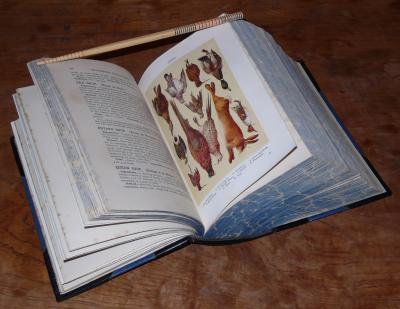Note: This entry has been restored from old archives.

Earlier today we wandered St. John’s before dropping the car back at the hotel. We caught a bus back into the town centre and had some time to kill before our next leg of travel took us to our evening destination, so we found ourselves wandering the streets again. It was still a miserable day, with the weather swinging between wind, snow, rain, and mixtures of the three. On one occasion as the wind picked up and the snow started coming in parallel to the ground we stepped into a narrow passage near the market square for shelter. A short way along we noticed the display window of a bookshop, it looked cosy and warm so in we went! At first it seemed a very usual sort of place, as little bookshops go, shelves tightly populated with myriad books from the pristine, through “slightly foxed,” to those that seemed to be on their way to compost. Then we turned the corner, phwoar! Rows of leather bound volumes, many in sets, several shelves behind glass. A veritable book heaven! I carefully examined some of my favourites, the few classics that I know well, such as Byron and Shakespeare. It was then that I saw Mrs Beeton, phwoar!
We’re talking the classic encyclopaedia of English cookery (inclusive of much of the “bad” English cookery the world knows), Mrs Beeton’s Household Management, complete with thousands (literally) of recipes. This 9.5cm thick, 2kg tome is occasionally referred to by culinary authors and I’ve always wondered at the passing asides with accompanying introductions such as “the great Mrs Beeton.” Though somewhat dated the content is a great historic reflection on English cooking. Some things, especially treatment of meats, are worth paying more attention to than others, but more about that later when I’ve had a chance to read more of the book. There were three copies of the “new edition” on the shelves, as well as a few lesser Mrs Beeton’s volumes covering only a subset of food and recipes. The new edition is introduced with a declaration that much has changed “especially since the War” and that these changes necessitated the release of this updated volume. We’re talking the Great War by the way, that’s the first “world” war. The editions available were all early 1900s printings, and are self-described as having “nearly twice the number of pages [and being] four times the size of its modest ancestor.”
I carefully located the Jugged Hare recipe, which doesn’t include blood, then turned to the section on preparing the hare. This is the sort of book we’re talking about, it covers everything from the moment the hare is brought in from the shoot to eating it. It’s supposedly an omnibus of all things a good housewife should know, not just food, but also cleaning, organising social occasions, and managing the servants! Perhaps a touch schizophrenic in this case, for how many women with servants need to worry about preparing a hare? Personally my interest is just in the British food lore of yesteryear, I’m only a so-so housewife.
I examined all three copies, including one kept behind glass. It turned out that the latter was only 10 quid more than one of the others and I preferred the look of the other. The man managing the collection said the one I preferred was better bound anyway, and the leather certainly did seem more robust (and should have a little neutral boot polish gently rubbed into it every few years.) The main issue (and thus reason for the price difference) was that the better cover was not the original cover, it’d been re-bound at some point in its life but it was definitely an edition from the 1920s or 30s (alas, books of those days didn’t always include convenient printing dates to aid in dating them.) Carried along by the moment and pushed in the back by the heady aroma of old books I bought it. It cost £130, extravagant no? But, to try to place it in some financial context: I recently attempted to buy a new video card for my PC, just a middle of the road one, and that would have cost the same amount. (I failed to buy the card, it was broken so I sent it back to Amazon and gave up on the whole idea.) This book is far more interesting, long-lived, and useful than some crummy piece of computer junk – a bargain even!
I eagerly look forward to having the time to selectively read my acquisition. For the next while though she’s just going to have to rub shoulders with the other, maybe less well-bred, books on my cooking shelf.
Later

The book is excellent, amusing, and informative. The aura of Mrs Beeton is one of a middle-aged to “certain aged” matriarch, with a lifetime of practice and experience in managing her household. How else could she write such a book and gain such a reputation? The truth is surprising, the real Mrs Beeton was in her early twenties when the book was written and was dead by 28! The latter, “new,” edition was extensively expanded and edited by other authors, particularly a “Mr C Herman Senn, M.B.E., F.R.H.S., assisted by some of the most famous chefs and teachers of the culinary arts.” (These latter “famous” contributors remain unnamed!) The original Mrs Beeton, it seems, has been superseded by an entirely different personality built on the expectations of readers. The fact is that “Mrs Beeton” is the book, the original author is inconsequential.
In all the book should be regarded as an encyclopaedia of its day, a gathering of knowledge. It seems likely that the original Mrs Beeton “borrowed” most of her content from other sources anyway. The first edition (written in Victorian times) was actually a collection of supplements she’d written over 2 years for a magazine published by her husband, so is likely to be a far different to the “new edition” I have (instilled with Edwardian sensibilities.) (Next project: get a copy of the first edition… or maybe not, they’re typically more than £1000!) I’ve picked up various facts like these while researching the book, the main goal being to date my copy. The information I can correlate between my copy and descriptions I can find online dates my copy to being published between 1923 to the mid-30s – this matches the date approximated by the guy at the store, reassuring.
What of the content? Some of it is highly worth testing out while other recipes are probably only of value as amusements, and would probably be illegal to carry out anyway! Take “Black Swan, Roasted or Baked” from the “Typical Australian Dishes” section for example! “Parrot Pie,” ingredients: “1 dozen paraquets” — “Wallaby, Jugged,” “In winter the animal may hang for some days, as a hare, which it resembles.” A wallaby resembles a hare? Barely. There’s also “Bandicoot and tomatoes.” There’s a recipe for “Pukaki, Jugged” but I have no idea what a Pukaki is and Google doesn’t help unless Mrs Beeton’s actually does mean we should stew an 18th century Maori chief! There’s also a set of pumpkin recipes that I really can’t place as “Australian.”
Much of the Australian content is amusing and it’d be hard to say if it is wrong or not without first catching and cooking a black swan or a wallaby. Next time I’m back home the wildlife better watch out… Also of note, the very brief Jewish section includes a recipe for stewed steak that includes “½ an oz. of butter or fat” and I’m pretty certain the butter would be verboten in this case (meat + dairy.) And these observations come from perusing just a couple of small and specific sections of the book.
Turning to the section on vegetables is a great reflection on the basis for the stereotypical English treatment of the poor old things. It’s also put some perspective on just how much has changed between then and now. The section devoted to vegetable recipes is only about 75 pages long. Here’s a list of “little known vegetables:” sorrel, scorzonera, sweet potato, maize (indian corn), yams, egg-plants, and custard apples. What an esoteric collection! Of course, sorrel, sweet potato, maize, egg-plants, and custard apples are everyday supermarket items now. Maize is now “corn,” but in those days “corn” was a generic term for grains (i.e. a modern reflection on this is that “cornflour” is actually made from wheat and not what we know as corn these days.) In the UK the “egg-plant” is known as the “aubergine,” I suspect its modern popularity in English cooking must mostly stem from French cuisine to have resulted in this name-change (in Australia eggplant is the common name.) Scorzonera is rare and better known as black salsify, I myself would not have recognised the name 6 months ago, and yams are known but hardly everyday. The vegetable section is also revealing in what it does not mention. No celeriac or swede at all for example!
How about cooking vegetables? Ah, mushy English vegetables. On boiling vegetables: “young vegetables with tender fibres will, as a rule, cook in about 20 minutes, whereas those fully mature, and consequently containing a relatively larger amount of fibrous substance, will average no less than 40 minutes.” I’m sure vegetables have been bred to be more tender in the last 80 years, but I can’t believe that 20 minutes for “young vegetables” was ever a good idea! For a case in point this is from the “Asparagus, Boiled” recipe: “boil gently for about 20 minutes.” Even though the asparagus was bundled into bunches of 20 I can hardly imagine 20 minutes resulting in much more than sloppy mush! Maybe in this case the vegetables of the day were tougher?
Where this book may have some interest for the modern day cook, rather than food historian, is in traditional treatments of various meats. Especially the more involved recipes and the stews (plainer “perfect roast” cooking has gained much from modern thinking, and oven technology, but Mrs Beeton does seem to have some agreement with even Hugh on some simple roasts – such as Snipe and Woodcock.) Several of the 40ish rabbit recipes are certainly worth some attention, as well as the 12 hare recipes and those for other game. The many offal/extremities recipes are warrant investigation as well (“Lamb’s Head and Pluck”), and even a decent proportion of the more everyday meat recipes.
If, in the future, I manage to try out a recipe or two from Mrs Beeton’s Household Management I’ll be sure to write it up. Perhaps this’ll mark the beginning of a collection of historic books on food, but that might be a bit too expensive. ‘Till then, try not to overcook your poor old vegetables or bake any protected wildlife.